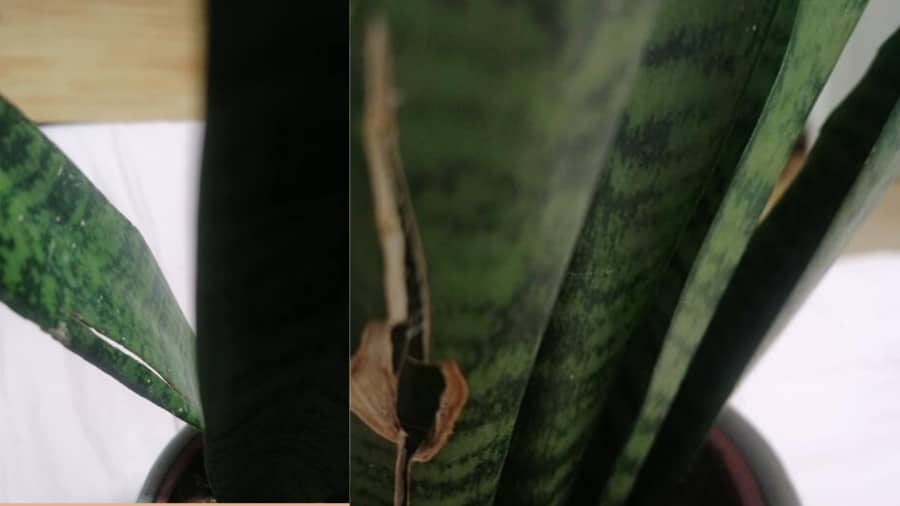If your snake plant’s leaves are splitting even though you’re ticking all the care boxes, something’s definitely off.
Snake plants are tough cookies—they can survive unfavorable conditions and even thrive in less-than-ideal environments. They don’t need much attention and can stick around for the long haul. So, what’s causing those unsightly splits in your snake plant’s leaves? Let’s dive in and find out.
Snake plant leaves splitting or cracking can be chalked up to several factors, including low humidity, physical injury, and nutrient deficiencies. A lack of boron can make the leaves brittle, leading to splits over time. On top of that, extreme temperatures and pesky pests might also be culprits.
Keep reading, and I’ll walk you through the causes and show you how to easily prevent your snake plant’s leaves from splitting.
Contents
Causes of Snake Plant Leaves Splitting and How to Fix Them
The leaves are the star of the show when it comes to snake plants. I get it—it’s a real bummer to see your snake plant sporting damaged leaves.
Splitting messes up their striking look and makes the plant less appealing. But hey, no need to hit the panic button.
There are ways to fix this. Let’s take a look at how we can tackle the problem.
1. Low Humidity
Low humidity is one of the main reasons why snake plant leaves split or crack.
When the air is dry, the leaves lose more water and get dehydrated. As a result, the low moisture content causes them to split or crack.
What to Do?
Here’s the game plan:
- Mist the leaves regularly. A light misting can boost humidity around the plant.
- Use a humidifier. This can maintain consistent humidity levels in your home.
- Try the DIY pebble tray method. Place some pebbles on a tray, pour in water until it’s just below the top of the pebbles, and set your snake plant pot on top. The evaporating water increases humidity around the plant.
2. Boron Deficiency
Boron is a micronutrient that snake plants need for forming cell walls and maintaining structural integrity. If your plant lacks boron, it’ll have a weaker overall structure—including its leaves. This makes the leaves brittle and more likely to split or crack.
What to Do?
- Check your soil’s pH. Soil that’s too acidic or too alkaline can prevent boron from being available to the plant. Aim for a pH between 5 and 6.5.
- Add organic matter to the soil. Compost or well-rotted manure can improve nutrient availability.
- Consider a micronutrient fertilizer. Look for one that includes boron to address any deficiencies.
3. Mechanical or Physical Damage
Roaming Pets
As much as we love our furry friends, sometimes they’re the culprits behind split leaves.
Pets can be one of the enemies of indoor plants. They love playing with them without realizing they’re causing damage.
What to Do?
- Place the plant somewhere safe. Keep it out of reach of pets, perhaps on a high shelf or in a room they can’t access.
- Use barriers. Set up a small fence or barrier around your plant.
- Elevate the plant. Use plant stands or hangers to keep it off the floor.
- Train your pets. Teach them to steer clear of your green babies.
Don’t get frustrated if your pets cause some damage to your plants. You’ll learn to find the balance in taking care of both. Just keep trying!
Mishandling
If you’re moving your snake plants around and aren’t careful, you can cause them physical harm. So before you rearrange and relocate them, make a plan.
What to Do?
- Plan your moves. Decide where you want each plant before you start moving them.
- Handle with care. Support the leaves and stems when lifting.
- Avoid overcrowding. Give each plant enough space to thrive.
- Protect during transport. Use plant caddies or trays to move them safely.
High Traffic Location
If your snake plant is in a high-traffic area, chances are it’ll experience splitting. High-traffic spots include doorways and hallways—places where people constantly pass through.
What to Do?
- Choose a low-traffic spot. Corners, windowsills, or tabletops can be great locations.
- Designate a plant area. Create a specific zone for your plants where they won’t be disturbed.
- Communicate with your household. Let everyone know to be mindful around your plants.
- Limit the number of plants if space is tight. It’s better to have fewer plants that are healthy than many that are damaged.
4. Extreme Temperature
Even though snake plants are pretty tolerant, too much of anything can be harmful. Extreme temperatures can cause stress among plants.
Ideally, snake plants thrive in temperatures ranging from 60 to 80°F (15–27°C). If the temperature gets extremely low or high, they’ll get damaged.
Snake plants especially dislike very cold environments—below 50°F (10°C). This becomes crucial during winter, so keep an eye on your plant.
What to Do?
- Don’t place near heat sources. Avoid placing your snake plant too close to heaters or fireplaces.ary, you can save them from possible harm. Make it a habit to check on them once in a while.
- Avoid drafts. Keep your plant away from doors, windows, and vents where cold or hot air can blow directly on it.
- Monitor indoor temperatures. Use a thermometer to ensure your plant’s environment stays within the ideal range.
- Use insulation. In colder months, consider insulating windows or moving the plant to a warmer spot.
5. Overwatering
Snake plants aren’t fans of too much water. If you’re overwatering, that’s probably why the leaves are splitting. Remember, your plant is a succulent that loves a dry environment.
Too much water intake will cause the leaves to expand rapidly. When the temperature rises and the transpiration rate is high, water gets used up, causing the leaves to shrink.
This sudden change between swelling and shrinking can damage the cells of the snake plant, leading to splitting.
What to Do?
- Adjust your watering schedule. Let the soil dry out completely between waterings. Typically, watering every 2-6 weeks is sufficient, depending on conditions.
- Use well-draining soil. A cactus or succulent mix works well.
- Ensure proper drainage. Make sure your pot has drainage holes to prevent water from pooling.
- Water less in cooler months. The plant uses less water when growth slows down.
Are Snake Plants Worth Another Try?
Absolutely! It’s normal to experience some hiccups when gardening. Just don’t throw in the towel. By now, you’ve probably learned why your snake plant’s leaves are splitting.
You can breathe a sigh of relief because most causes of such damage are actually easy to manage and preventable.
Follow the tips above and see how they fix the problem. Are you ready to give it another shot?
Happy planting!








